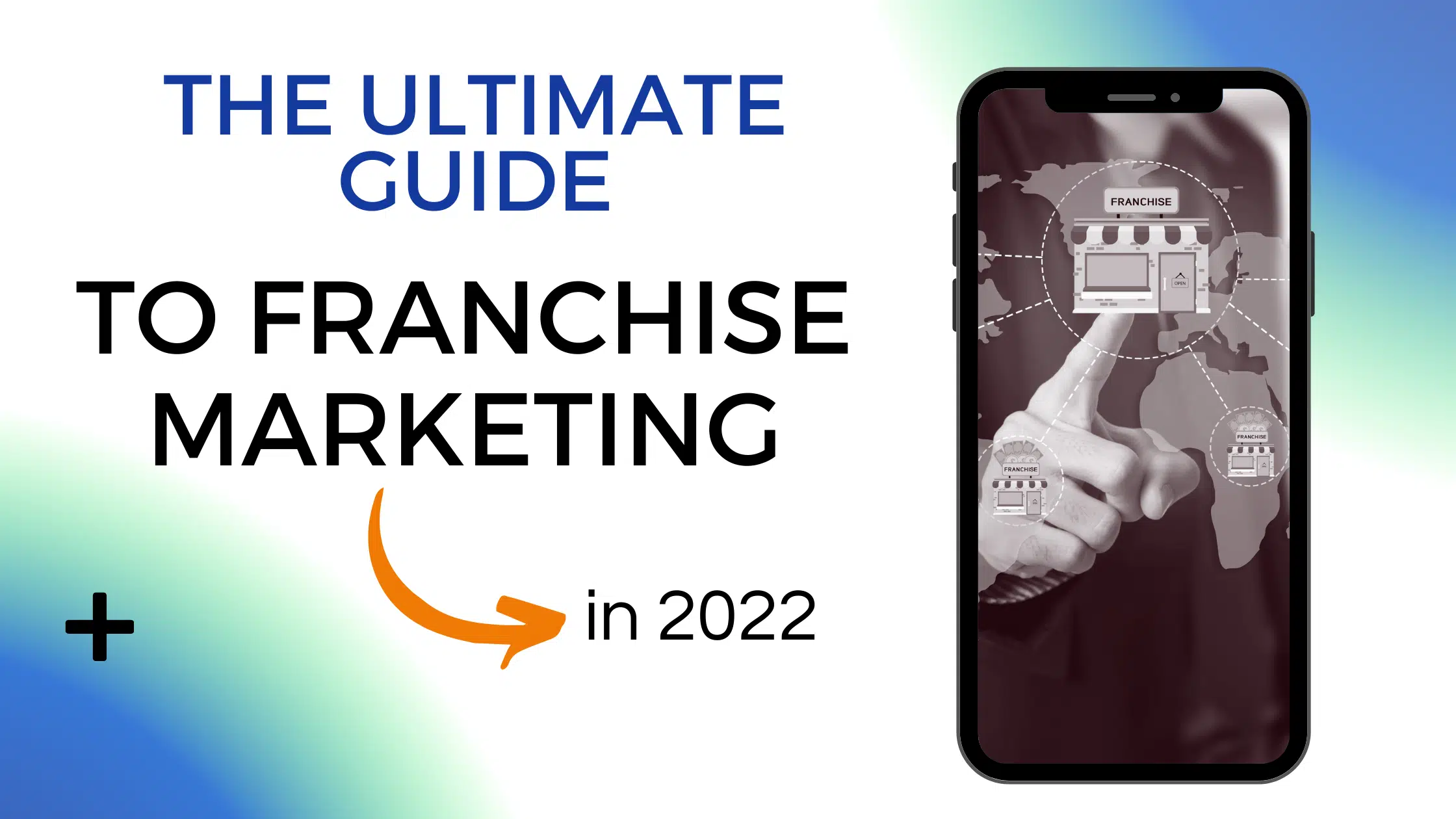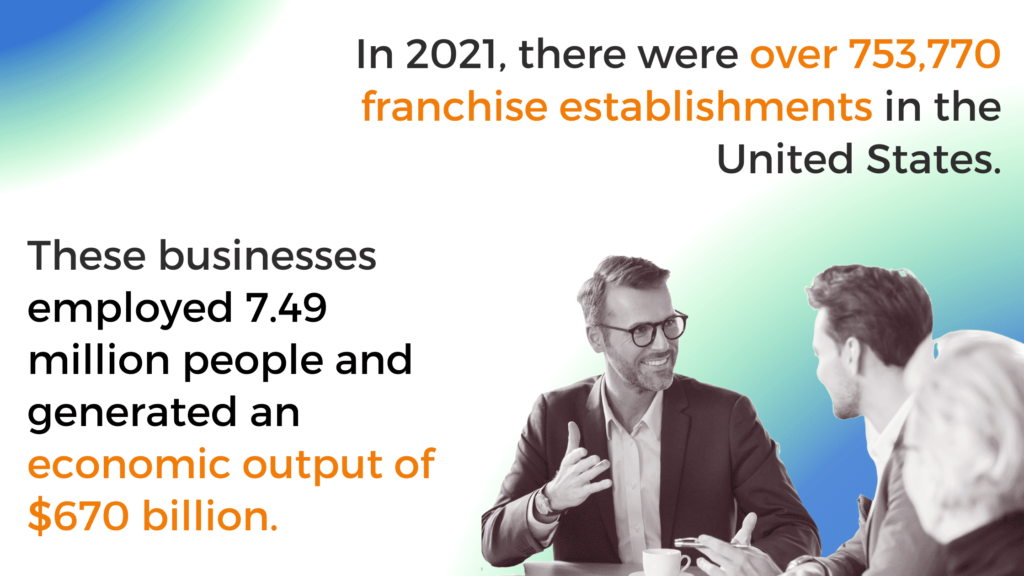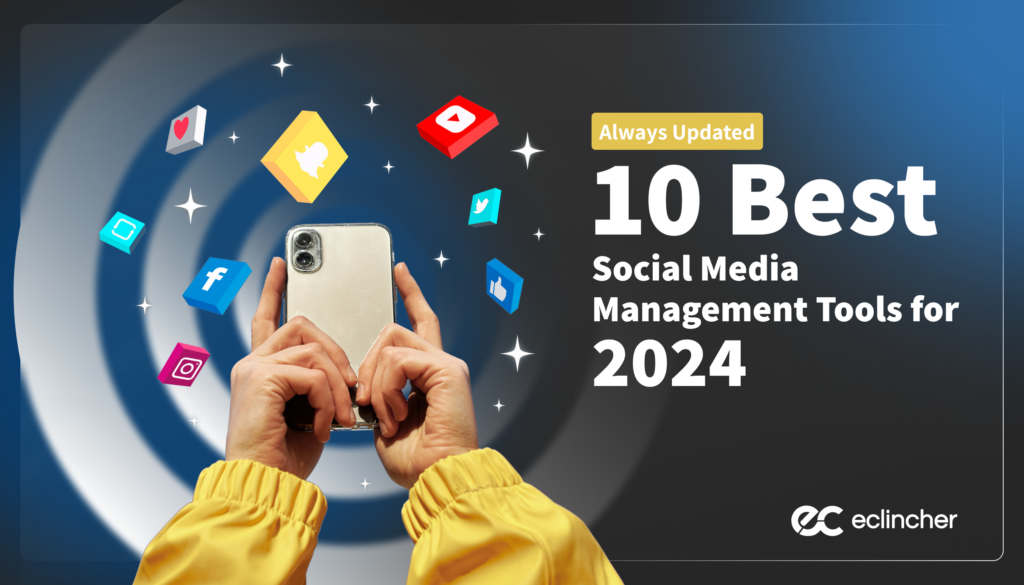Franchising is a big business. In 2021, there were over 753,770 franchise establishments in the United States. These businesses employed 7.49 million people and generated an economic output of $670 billion.
Franchising offers a unique opportunity for the franchisor (think Subway) and the franchisee (think your locally-owned Subway store).
New franchisees can buy into a business with an established reputation, industry expertise, and a built-in customer base. Franchisors get to expand to new locations via the expertise of locals familiar with the area and its inhabitants.
However, owning a franchise brand isn’t always easy, and one of the biggest challenges is franchise marketing.
That’s what this article is all about. We’ll cover the ABCs of franchise marketing, six digital marketing strategies you can try, social media marketing tips to help you maximize your investment, and examples you can use for inspiration.
What is Franchise Marketing?
Before we dive into the nuances of franchise marketing, let’s define a few key terms. First, “franchise marketing” refers to any promotional activities undertaken by a franchisor or a franchisee.
Those promotional activities could include paid or organic content (organic content is content you don’t pay any direct costs for, like a social media post). And when we talk about franchise strategies, we think about them in five specific marketing subcategories:
- Public Relations = which aims to bolster your brand reputation
- Advertising = which is paid marketing that promotes your brand or offering
- Sales promotion = which offers deals to close sales (like offering 15% off or free shipping)
- Direct marketing = which is marketing targeted at a specific person or business
- Personal selling = which is when a salesperson sells an item to a customer
Promotional strategies don’t fit neatly into a single marketing subcategory. For example, a social media post sharing a 10% discount coupon fits under both the “public relations,” “sales promotion,” and “advertising” umbrellas.
Types of Franchise Marketing
Though the marketing activities undertaken by franchisors and franchisees may look similar, they fall into two distinct types of franchise marketing:
1. Operational Franchise Marketing
Both franchisors and franchisees use operational franchise marketing. Operational franchise marketing has three elements and goals.
First, it aims to win new leads and clients for the business. Marketers use promotional strategies like Paid-Per-Click (PPC) advertising, local Search Engine Optimization (SEO) campaigns and offline marketing strategies like TV ads for this goal.
Second, it aims to keep customers engaged so they make a repeat purchase. Marketers use strategies like email marketing, targeted social media campaigns, loyalty clubs, and exclusive offers for this goal.
Finally, it aims to increase brand awareness so people become familiar (and thus comfortable) with the brand. Though there are hundreds of ways to build brand awareness, many businesses focus on public relations, local SEO, word-of-mouth marketing, community-based marketing, and reviews.
2. Franchise Development Marketing
You probably don’t need to worry about franchise development marketing if you are a franchisee. Franchisors engage in this type of marketing to build a business that potential franchisees in fresh markets will want to invest in.
Naturally, franchise development marketing has three primary objectives:
- Build a strong brand that customers will recognize and want in their area
- Establish trust and credibility as a business that franchisees want to partner with
- Convey the expertise and knowledge your business has so new franchisees feel safe investing
Marketers use word-of-mouth marketing, public relations campaigns, industry accolades, and advertising targeting potential investors to reach these goals.
Digital Marketing Strategies for Franchises
Now that we’ve covered the “what” of franchise marketing, let’s dive into the “how.” Here are six digital marketing strategies for franchises:
Strategy 1. Your Website
Imagine this: you want to order food from a new franchise restaurant near you, but you don’t know if they have options suitable for your diet. So, where would you find this information?
Like 77% of diners, you might visit the restaurant’s website before placing an order. And if you don’t like what you see, you might join the 68% of people who’ve been discouraged from a restaurant by its website.
It doesn’t matter if you sell through your website or not. Your website is a digital home for your business. It educates customers about your products and tells your brand’s story.
How do you market your brand through your website? Make sure you:
- Make your website easy to navigate
- Use videos, animations, images, infographics, and other forms of interactive media to grab people’s attention
- Use persuasive and clean copy
- Use Click-Through Actions (CTAs) to get people to take desired actions like buying something or making contact
Additionally, your website must work on iOS and Android devices.
There are currently 4.32 billion mobile internet users worldwide, and 56.89% of internet traffic comes from mobile devices. So if we assume that a similar percentage of your potential customers are on mobile, you could miss out on nearly half your website visitors if you don’t make your website mobile-friendly.
If you’re looking for inspiration, here’s how “movers who care” Two Men and a Truck structured its website on desktop…
Source: TwoMenAndATruck
And on mobile:
Source: TwoMenAndATruck
Of course, if you are a franchisee, you may not have much control over your website’s design or mobile accessibility. However, you can still make sure that:
- Your contact information is correct
- Your business address is listed clearly
- Any images or videos of your business look professional
Strategy 2. National SEO
National SEO is exactly what it sounds like: SEO efforts that target consumers nationally. The goal of national SEO is to increase your website’s performance in Search Engine Page Results (SERP) — an action that’s vital in increasing traffic.
Why?
Research on 80+ million keywords and billions of results shows that 28.5% of searchers click on the first Google result, 15.7% click on the second, 11% click on the third, and 24.8% click on the fourth to tenth results.
Source: Sistrix
If you want to see the power of a national SEO campaign, you only need to look at Canva. Canva used SEO to get over 270 million annual website visitors and over 4 million backlinks (links to your website from other websites).
Here’s what Canva did:
- Organized its website with parent and child relationships for easy navigation
- Invested in building backlinks
- Created SEO-optimized content through its blog
- Developed a template for landing pages so it could target top-ranking keywords like “free flyer maker” with a specific landing page
Canva also optimized its website around the user. For example, Canva built these two landing pages for users with different needs:
Source: Foundationinc.co
The one on the left is for people who need to create a certificate quickly. The other is for people who want a certificate template. Though these may look similar, each page helps the user reach a different goal.
If you want to create a national SEO campaign like Canva, here are some other strategies you can try:
- Speed up your website (as 47% of consumers want a website to load in two seconds or less)
- Build links to high-quality sources
- Optimize your images
- Embrace content marketing
Strategy 3. Local SEO
Local SEO is the natural counterpart to national SEO.
Did you know that 46% of Google searches look for local information? It’s true. Data from Go-Globe shows that 86% of consumers use the internet to find local businesses. Nearly one-third (29%) do this weekly.
The message here is clear: putting your business online for locals is a franchise marketing strategy that pays off. Specifically, it boosts your local visibility, increases your traffic, personalizes the customer experience for your local consumers, and gets you more actionable data.
One of the best ways to improve your local SEO is to create a Google My Business listing for your business. Like this example from Lincraft Malvern, your Google My Business will show customers your address, phone number, website, and opening hours.
Source: Google
Once you’ve set up your listing, try a few of these strategies:
- Optimize your website for voice search, so you appear in searches made from Alexa, Siri, Cortana, and Google Assistant
- Post content related to local news stories to draw in local traffic
- Target local keywords related to your business. For example, a dry cleaning franchise could target “dry cleaner near me” or “dry cleaner (town).”
And, of course, “Strategy 4. Review Platforms” will also help with local SEO.
Strategy 4. Online Review Platforms
According to BrightLocal’s Local Consumer Review Survey 2020, 94% of consumers say that a favorable review makes them “more likely to use a business,” while 92% say that negative reviews make them “less likely to use a business.”
How should you market your business through reviews?
The first step is to set up a business profile on local review websites like Yelp, the Better Business Bureau, TrustPilot, TripAdvisor, Foursquare, Angie’s List, and ConsumerReports. Setting up a Google My Business account will also allow people to leave Google reviews for your business.
Next, ask customers to leave you a review. You could ask them through social media, product packaging, email marketing, a card you give out at checkout. If your customers are tech-savvy, you could even place a QR code in your store that links people to a review platform.
Finally, reward people who leave you a review. Great rewards include free shipping, a gift, or a discount on their next purchase. Alternatively, get creative and start a Refer a Friend program like Quip. Quip gives the referrer and new customer $5 credit to spend in-store.
Source: Quip
When discussing reviews, many business owners ask, “are reviews 100% important in every industry?”
The BrightLocal survey shows that reviews are more critical in some industries than others. More than 87% of consumers of restaurants, cafes, hotels, healthcare, automotive services, clothing stores read reviews before purchasing.
If you are in one of these industries, treat cultivating reviews like winning new customers. It’s vital to your success.
Source: BrightLocal
Strategy 5. Email Marketing
No marketing strategy is complete without email marketing. Email marketing has the highest Return-on-Investment (ROI) of any marketing technique, as brands get $36 for every $1 they spend.
Email marketing is also a very flexible form of marketing. Your strategy can be as simple or thorough as you like, and you can be as creative as you want.
Implementing an email marketing strategy is pretty simple. Here’s how:
1. Define Campaign Goals
First, you need to set a goal for your email marketing campaign. Setting a goal will help you evaluate your campaign to ensure it’s working. The best goals are SMART (Specific, Measurable, Achievable, Realistic, and Time-Bound).
To set a SMART goal, try this formula: “by (time), (brand) will (milestone) by (strategy).” For example, “by December, Yult will decrease cart abandonment by 10% by sending out cart abandonment emails.”
When setting a milestone, consider choosing a Key Performance Indicator (KPI) that defines whether you were successful or not. Here are some SMART goal-friendly KPIs we recommend for email marketing:
- Cart abandonment rate
- Click-Through Rate (CTR)
- Click-To-Open Rate (CTO)
- Bounce rate
- Unsubscribe rate
- List growth rate
2. Grow Your Email List
Next, you need to select an email marketing service. Popular platforms include Constant Contact, SendinBlue, Drip, HubSpot, and ConvertKit.
Connect your email marketing service to your website so people can sign-up for it. You can do this by adding it to your homepage, placing a link in the header or footer of your site, creating a chatbot, or using a pop-up like this:
Source: SoggyDoggyDoormat
People are more likely to join your email marketing list if you give them an incentive. For example, you could offer them 20% off, offer them exclusive information about new releases, or give them free shipping.
3. Welcome New Subscribers
Finally, build a welcome email to greet new email subscribers. Your welcome email should include:
- A “thank you” for subscribing
- An introduction to your brand
- Visual elements that grab people’s attention (like animations, images, or infographics)
- What subscribers can expect from your emails
- A strong subject line
If you are looking for inspiration, here’s an example of a welcome email from Canstar:
After you’ve drafted your welcome email, design a targeted email marketing strategy (sometimes called a “segmented email strategy”). A targeted strategy makes subscribers 50% more likely to click through to your website, as it sends subscribers specific information you think they’ll find interesting.
There are many ways to target your emails:
- By demographic, including age, gender, and location
- By industry
- By behavior, including sending cart abandonment emails, upselling emails, and follow-up emails after a purchase
If you’d like to learn more about email segmentation, see “The Beginner’s Guide To B2B Email Segmentation.”
Strategy 6. Social Media Marketing
Finally, we reach social media marketing. In other businesses, starting a social media marketing campaign can be as straightforward as opening accounts, planning a social media strategy, and putting it into action.
Franchise businesses operate a little differently. Your franchising agreement will likely clearly state what franchisees and franchisors can do with social media. As each of these agreements is subjective, you’ll need to refer to your contract for advice for your business.
However, franchises commonly divide roles like this:
Franchisor
The franchisor will maintain officially branded social media accounts on all major platforms, including Facebook, Instagram, Twitter, Pinterest, and TikTok. The franchisor will post advertisements, chain-wide discounts, and behind-the-scenes content to engage followers.
Franchisee
The franchisee will maintain a branded account on platforms popular in their local area. In addition, the franchisee can promote storewide discounts, local events, local specials, and activities that concern their specific store.
Generally, the franchisee will also need to make sure their strategy:
- Uses the brand voice of the parent company
- Adheres to the rules in the parent company’s social media marketing guide
- Only uses art, logos, and images approved by the parent company
- Only promotes discounts and specials endorsed by the parent company
If you’re wondering what the division of these roles looks like in practice, you can see it by looking at franchisor and franchisee accounts from brands like Hungry Jacks.
Here is the franchisor’s Facebook account:
Source: Facebook
Here is a franchisee’s Facebook for the Melton location:
Source: Facebook
Looking at these images, you may notice the message icon is missing from both pages.
“Who will answer customers’ messages?” is an issue for many franchises. On the one hand, parent companies may have a customer service team to respond to these messages 24/7.
On the other hand, franchisees can answer location-specific questions better and faster. After all, who is better equipped to answer a question like, “is your soft serve machine working?”
Some franchises address this problem by using Facebook Locations. Facebook Locations allows franchisors to have an official account with many child accounts for franchisees. When people send a page a message, the franchisor can divert it to the appropriate recipient.
There are many ways to sort messages with Facebook, including:
- By Location
This one is simple. If a message comes from someone living in Geelong, the message goes to the Geelong franchise. If there is no location listed in the sender’s profile or the message text, the message goes to the parent company.
- By Chatbot
Social media platforms like Facebook let you use a chatbot to answer customer questions. For example, you can set your chatbot to ask customers where they are and direct customers to their nearest franchise.
Alternatively, you can ask customers to select what their question is about, then direct them to the correct department. For example, “does your question concern warranty and returns, filing a complaint, product query, or something else.”
Facebook has an inbuilt chatbot, Facebook Messenger Bot, but you can also add third-party bots. If you’d like more information on chatbots, read: “The Beginner’s Guide To Chatbots.”
Social Media Marketing Tips
In 2022, an estimated 3.98 billion people will use social media, and users spend an average of 145 minutes on social media per day.
As social media allows you to connect with local consumers affordably and quickly, it’s safe to say it’s the “thing” that helps many franchises succeed. However, developing a social media strategy that adheres to industry best practices can be tricky if you don’t have a social media background.
To finish this article, we’ll share five tips that can help you boost your strategy from “okay” to “fantastic.”
1. Create Detailed Policies
A social media policy is a detailed document that guides how franchisees and franchisors use social media. Creating a policy helps you remain professional, defends you against security risks, and protects your brand.
Here are some things to include in your strategy:
- Roles and responsibilities
- Security protocols
- Brand voice guidelines
- How you will adhere to copyright laws
- Guidance for employees participating in social media (including those featured in images)
2. Use Templates
Creating your own images from scratch is time-consuming and requires strong design skills. That’s why franchisors need templates.
Developing templates is a great way to ensure franchisees only post high-quality content on their social media pages. You can develop these in-house, then distribute them to franchisees through a digital asset library.
3. Use An Approval-Based System
An approval-based system allows the franchisee to create custom contact from scratch and post it with the guarantee that it’s “corporate-approved.”
To set up an efficient approval system, create a list of things to check on each social media piece. Then, select a social media expert to check each piece.
If you can, use a social media pic tool to collate all content for approval, so it’s easy to keep track of. It might also help to create lists of “no’s” franchise staff can read through to make sure their post is red-flag-free.
4. Post Relevant Content
So far, this article has focused on the “why” and “how” of social media, but not the “what.” Though you may think the only thing you can post on social media is text and images, the best strategies take advantage of many post types. Post types include:
- Live Streams
- Infographics
- Polls
- User-Generated Content (UGC)
- Quizzes
- Videos
- Giveaways
- Contests
- Reviews and testimonials
When selecting the type of content to post, ask yourself: “what gets my customers excited?” Go from there.
5. Distribute Branded Content Across Different Franchisee Platforms
Social media experts use the “80/20” rule to guide their social media calendars. This rule says that 20% of your content should be promotional, while the other 80% should be informative, organic, and fun.
As the promotional 20% makes you sales, it’s essential to get it right. We recommend that franchisors create promotional content in-house and distribute it to franchisees to post on their platforms. This technique ensures each location posts high-quality promotional material, ultimately boosting sales nationwide.
Frequently Asked Questions
What are examples of franchise marketing?
Email marketing & SEO are examples of franchise marketing. These two methods can help bring eyeballs to your business website and increase sales.
Why is franchise marketing important?
Franchise marketing is important for maintaining your brands reputation. Effectively marketing to your target audience will help drive long term sales growth and improve the public’s perspective of your franchise.
What are the 4 types of franchising?
The most common 4 types of franchises are Single-unit, multi-unit, area development and master franchising. The best type of franchise will determine the industry you are trying to enter.
What industry is the best to franchise?
One industry that is especially well-suited to franchising is fast food. The fast-food sector has been one of the most successful franchise environments, particularly in the United States and Canada, due to its low start-up costs and quick return on investment (ROI). Brands like McDonalds and Burger King have famously opened hundreds of franchises around the world, with many more small and local businesses joining their ranks every year.
Level Up Your Business With Franchise Marketing
Learning to master franchise marketing is vital whether you’re a franchise owner or a parent company. Franchise marketing employs many of the same techniques as traditional small business marketing, but there are some key differences:
- Parent companies guide franchisees in their marketing efforts
- Marketing at one location influences sales at others
- Franchisees may have limited access to some marketing channels
- Social media marketing for franchises can be overwhelming
Naturally, you’ll need to approach your marketing strategy with care and make sure you design a strategy that’s brand-approved and customer-focused. Then, let your creativity run wild.
If you are looking for a software tool to centralize your social media marketing efforts, franchise marketing can be simplified with eclincher. Their social media management software is barnone in the value offered coupled with the 24/7 award-winning support team. eclincher offers a free personal demo and a no pressure 14-day trial. Check them out!









